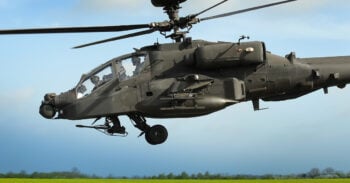
U.S. Paratroopers assigned to the 82nd Airborne Division board a C-17 Globemaster III to depart Ft. Bragg for the U.S. European Command area of responsibility at Pope Army Airfield, N.C., Feb. 4, 2022. (U.S. Army/Jillian G. Hix)
When the Biden administration came into office, the expectation was that defense spending would be flat, or more likely cut, in future budgets. But the world has changed significantly in the last year, and now, argues John Ferrari, a retired Army budget official, it’s time for the Biden administration to change its plans to match.
The recent release of the January inflation report, the news that a bipartisan deal has been reached for the FY22 funding in Congress, and the admission by the Army Secretary that OMB has yet to give final guidance for fiscal 2023 has left a window of opportunity open for the Biden administration to prevent the erosion of US military capability in the face of both Russian and Chinese provocations.
With inflation now at 7.5%, the Defense Department is being squeezed by the inflation anaconda as was predicted many months ago. The most pernicious near-term effects will be mitigated by the additional funding in FY22 that will be provided by Congress, assuming that the appropriators provide the same $777.7B topline that is in the NDAA, but it sets up a situation for FY23 where the department will be in a hole before the next budget request even drops.
The Biden administration came in with expectations of flat or declining defense spending, but the state of the world, combined with inflation, means OMB has to be realistic. And realistic, in this case, means a big number: a topline of $816 billion for the Pentagon in FY23.
Yes, that’s a $60 billion increase over what the Biden administration budget projections forecasted for defense as part of its FY22 budget submission. And yes, $60 billion more is a lot of money. But a lot has changed in the last year, and in real terms, that represents only an 8% increase over their previous forecast and only 5% higher than the NDAA agreed upon level from FY22 — and this is not even as large as some defense leaders who have famously said that they need 3-5% growth on top of inflation.
RELATED: Surviving The Inflation Anaconda: Congress Must Invest More In Defense
So where would that $60 billion go towards? Start with America’s most important asset: our servicemembers. The FY22 NDAA, even with its planned increase, does not track with the inflation impact on our service members, and a 7.5% increase in costs with only a 2.7% increase in pay will severely impoverish our lowest ranking troops. For FY23, the law calls for a pay raise of only 4.7%, which does not even make up for the lost buying power this year.
OMB should direct DoD to submit a military pay raise of at least 7% for FY23 off the bat, as a sign of good faith with the men and women who serve. Providing that raise, as well as funding medical inflation and other associated military personnel accounts, requires $12B in spending.
Another $20B would be added to the Pentagon’s procurement and research accounts, to help match up to congressional additions in the FY22 budget which were not part of the administration’s FY22 request. It would be foolish to assume that Congress added these funds in March and won’t back them again months later, so the administration should avoid the inevitable yelling by members and factor that spending in off the bat.
Next is the current readiness of the force. The Air Force recently reported that it is cutting its flying hours in order to cover increased sustainment costs, the Army is going to have to cut back training to pay for the deployments to Europe, and the Navy stated that it would have to reduce training exercises due to the lack of a timely FY22 budget. Between fuel price increases, deployments to Europe to counter Russian threats, and increases in the costs of spare parts, the readiness funds need to be increased by 7%, which is about $20B.
After those three pots of money, there will be another $8 billion of the $60 billion left to fund advanced weapons such as hypersonics, space, and cyber, without resorting to the bloodletting predicted by the Chairman of the Joint Chiefs, Gen. Mark Milley.
Getting an FY23 budget approved is setting up to be a major challenge. First, the administration will deliver it late to Congress; it was supposed to be out already but now is likely to come in late March, after the FY22 negotiations finally settle down. Given what will be a contentious mid-term election, we can expect the congressional calendar to be squeezed, making the prospects for starting FY23 under a continuing resolution likely.
The delay in getting the budget topline sorted provides an opportunity, however. OMB should take advantage of the bipartisan consensus on FY22 that has just emerged, and work with the appropriators to negotiate the FY23 topline right now. Then the administration can send over the budget within that topline and maybe, just maybe, Congress can appropriate the FY23 budget on time, showing the American people that our government can function.
In FY22, the administration ripped a page out of the many previous budget playbooks by competing the defense and non-defense parts of the budget against each other. Congress, to get the omnibus appropriation approved, then negotiates a spending deal to increase both sides of the ledger – as has happened once again this year. The result of this budget gamesmanship is distorted planning and execution.
Right now, for example, DoD is planning to terminate programs and allocate training in FY22 based upon a topline that is $24 billion less than what Congress will likely appropriate in just a few weeks. There will then be a mad rush to spend these new dollars, which is wholly inefficient, as has been pointed out by Elaine McCusker, the former acting Comptroller of DoD.
Setting a realistic larger defense topline of $816 billion alleviates the need for Congress to plus up the administration’s budget and cause that mad dash. It will also be a strong signal to both Russia and China that our military forces will be ready and capable to both deter aggression and if deterrence fails to defend our national interests.
OMB can fight against a defense increase and force a long, protracted fight in Congress, or it can accept reality and do what is best by both America’s interests abroad and America’s servicemembers. The ball is in their court — and the clock is ticking.
Maj. Gen. John Ferrari, US Army (ret.), is a visiting fellow at the American Enterprise Institute (AEI), a former director of program analysis and evaluation for the US Army, and the chief financial officer at QOMPLX.
HASC pushes for reciprocity guidance for cloud computing in draft NDAA language
The legislation proposes that if one office in the department officially deems a “cloud-based platform, service, or application” is sufficiently cybersecure to use, then all parts of DoD can accept this ATO.



























